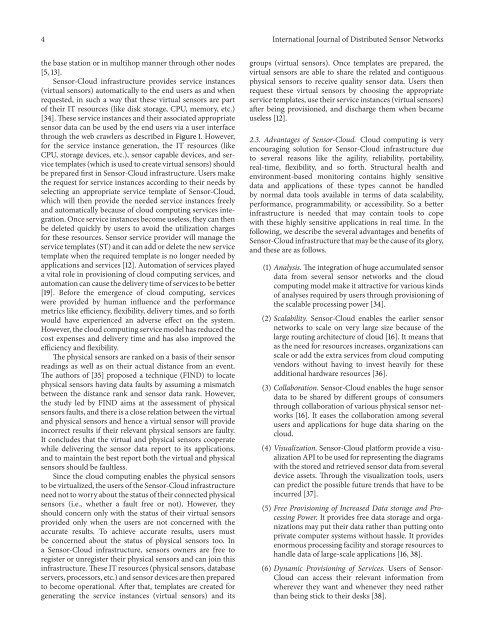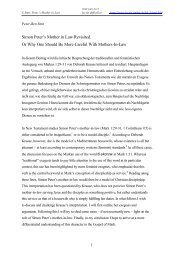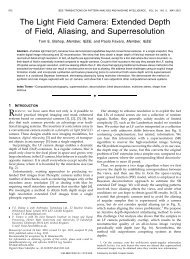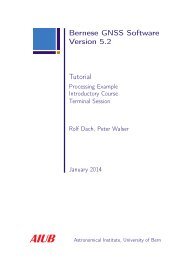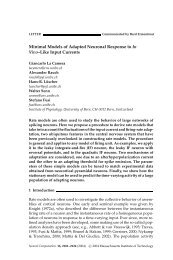Deploying Real-Life WSN Applications: Challenges ... - IAM - CDS
Deploying Real-Life WSN Applications: Challenges ... - IAM - CDS
Deploying Real-Life WSN Applications: Challenges ... - IAM - CDS
Create successful ePaper yourself
Turn your PDF publications into a flip-book with our unique Google optimized e-Paper software.
4 International Journal of Distributed Sensor Networks<br />
the base station or in multihop manner through other nodes<br />
[5, 13].<br />
Sensor-Cloud infrastructure provides service instances<br />
(virtualsensors)automaticallytotheendusersasandwhen<br />
requested, in such a way that these virtual sensors are part<br />
of their IT resources (like disk storage, CPU, memory, etc.)<br />
[34]. These service instances and their associated appropriate<br />
sensordatacanbeusedbytheendusersviaauserinterface<br />
through the web crawlers as described in Figure 1. However,<br />
for the service instance generation, the IT resources (like<br />
CPU, storage devices, etc.), sensor capable devices, and service<br />
templates (which is used to create virtual sensors) should<br />
be prepared first in Sensor-Cloud infrastructure. Users make<br />
the request for service instances according to their needs by<br />
selecting an appropriate service template of Sensor-Cloud,<br />
which will then provide the needed service instances freely<br />
and automatically because of cloud computing services integration.<br />
Once service instances become useless, they can then<br />
be deleted quickly by users to avoid the utilization charges<br />
for these resources. Sensor service provider will manage the<br />
service templates (ST) and it can add or delete the new service<br />
template when the required template is no longer needed by<br />
applications and services [12]. Automation of services played<br />
a vital role in provisioning of cloud computing services, and<br />
automationcancausethedeliverytimeofservicestobebetter<br />
[19].Beforetheemergenceofcloudcomputing,services<br />
were provided by human influence and the performance<br />
metrics like efficiency, flexibility, delivery times, and so forth<br />
would have experienced an adverse effect on the system.<br />
However, the cloud computing service model has reduced the<br />
cost expenses and delivery time and has also improved the<br />
efficiency and flexibility.<br />
The physical sensors are ranked on a basis of their sensor<br />
readings as well as on their actual distance from an event.<br />
The authors of [35] proposed a technique (FIND) to locate<br />
physical sensors having data faults by assuming a mismatch<br />
between the distance rank and sensor data rank. However,<br />
the study led by FIND aims at the assessment of physical<br />
sensors faults, and there is a close relation between the virtual<br />
and physical sensors and hence a virtual sensor will provide<br />
incorrect results if their relevant physical sensors are faulty.<br />
It concludes that the virtual and physical sensors cooperate<br />
while delivering the sensor data report to its applications,<br />
and to maintain the best report both the virtual and physical<br />
sensors should be faultless.<br />
Sincethecloudcomputingenablesthephysicalsensors<br />
to be virtualized, the users of the Sensor-Cloud infrastructure<br />
need not to worry about the status of their connected physical<br />
sensors (i.e., whether a fault free or not). However, they<br />
shouldconcernonlywiththestatusoftheirvirtualsensors<br />
providedonlywhentheusersarenotconcernedwiththe<br />
accurate results. To achieve accurate results, users must<br />
be concerned about the status of physical sensors too. In<br />
a Sensor-Cloud infrastructure, sensors owners are free to<br />
register or unregister their physical sensors and can join this<br />
infrastructure. These IT resources (physical sensors, database<br />
servers, processors, etc.) and sensor devices are then prepared<br />
to become operational. After that, templates are created for<br />
generating the service instances (virtual sensors) and its<br />
groups (virtual sensors). Once templates are prepared, the<br />
virtual sensors are able to share the related and contiguous<br />
physical sensors to receive quality sensor data. Users then<br />
request these virtual sensors by choosing the appropriate<br />
service templates, use their service instances (virtual sensors)<br />
after being provisioned, and discharge them when became<br />
useless [12].<br />
2.3. Advantages of Sensor-Cloud. Cloud computing is very<br />
encouraging solution for Sensor-Cloud infrastructure due<br />
to several reasons like the agility, reliability, portability,<br />
real-time, flexibility, and so forth. Structural health and<br />
environment-based monitoring contains highly sensitive<br />
data and applications of these types cannot be handled<br />
by normal data tools available in terms of data scalability,<br />
performance, programmability, or accessibility. So a better<br />
infrastructure is needed that may contain tools to cope<br />
with these highly sensitive applications in real time. In the<br />
following, we describe the several advantages and benefits of<br />
Sensor-Cloud infrastructure that may be the cause of its glory,<br />
and these are as follows.<br />
(1) Analysis. The integration of huge accumulated sensor<br />
data from several sensor networks and the cloud<br />
computing model make it attractive for various kinds<br />
of analyses required by users through provisioning of<br />
the scalable processing power [34].<br />
(2) Scalability. Sensor-Cloud enables the earlier sensor<br />
networkstoscaleonverylargesizebecauseofthe<br />
large routing architecture of cloud [16]. It means that<br />
as the need for resources increases, organizations can<br />
scale or add the extra services from cloud computing<br />
vendors without having to invest heavily for these<br />
additional hardware resources [36].<br />
(3) Collaboration. Sensor-Cloud enables the huge sensor<br />
data to be shared by different groups of consumers<br />
through collaboration of various physical sensor networks<br />
[16]. It eases the collaboration among several<br />
users and applications for huge data sharing on the<br />
cloud.<br />
(4) Visualization. Sensor-Cloud platform provide a visualization<br />
API to be used for representing the diagrams<br />
with the stored and retrieved sensor data from several<br />
device assets. Through the visualization tools, users<br />
canpredictthepossiblefuturetrendsthathavetobe<br />
incurred [37].<br />
(5) Free Provisioning of Increased Data storage and Processing<br />
Power. It provides free data storage and organizations<br />
may put their data rather than putting onto<br />
private computer systems without hassle. It provides<br />
enormous processing facility and storage resources to<br />
handle data of large-scale applications [16, 38].<br />
(6) Dynamic Provisioning of Services. Users of Sensor-<br />
Cloud can access their relevant information from<br />
wherever they want and whenever they need rather<br />
than being stick to their desks [38].


